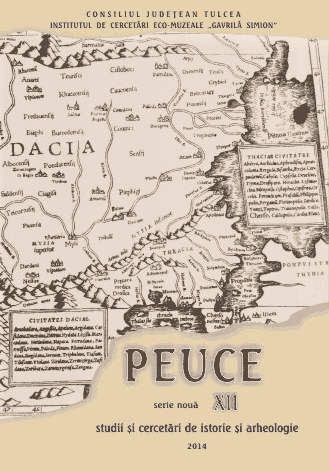Troesmis şi romanii la Dunărea de Jos. Proiectul Troesmis 2010-2013
Troesmis and the Romans at the Lower Danube. Troesmis Project 2010-2013
Author(s): Cristina-Georgeta Alexandrescu, Christian GuglSubject(s): Archaeology
Published by: Institutul de Cercetari Eco-Muzeale Tulcea - Institutul de Istorie si Arheologie
Keywords: Moesia inferior; Troesmis; legio V Macedonica; Roman period; Byzantine period; municipium; geomagnetic prospections; survey; necropolis; tumuli; roads. Cuvinte cheie: Moesia inferior; Troesmis; legio V Macedonica; epocă romană; epocă bizantină; municipiu
Summary/Abstract: Since 2010, a Romanian-Austrian research project has investigated the site of ancient Troesmis (near today’s Turcoaia, Tulcea County), focusing on the transformations undergone by settlements at the Lower Danube in antiquity. By applying innovative archaeological documentation and evaluation methods (digital documentation of findings, photogrammetry, geophysical prospection and geo-information technology), the site of Troesmis was examined in order to serve as an example for the transformation of the settlement and habitat from the 2nd to the early 13th century A.D. Located in the northwest of Dobrudja, Troesmis occupied a strategic key position on the Roman Danube limes. The Roman-Byzantine settlement was situated on the steep right bank of the Danube, about 15 km to the south of present-day town of Măcin and 4 km to the north of Turcoaia village. The wide-spread area of the ruins that is dominated today by two fortifications extends from the Danube to the east, up to the foothills of Măcin Mountains. This paper intends to give an overview on the 2011-2013 field campaigns that focused on the topographic documentation of the still visible ruins of two fortifications (the so-called eastern fortification, from the Late Roman period, and the western fortification, dated to the middle Byzantine period), as well as of the visible remains on the plateau, which were part of a settlement. In addition to the critical review of the research, an intensive survey over about 178 ha was carried out along with geomagnetic prospection, covering an area of about 48 ha, providing new insights into the site’s settlement structure. Rezumat: Din 2010 un proiect de cercetare român-austriac investighează situl antic de la Troesmis (aproape de com. Turcoaia, jud. Tulcea), urmărind studierea proceselor de transformare prin care au trecut în antichitate așezările la Dunărea de Jos. Prin utilizarea unor metode de documentare și evaluare arheologică inovatoare (documentare digitala a rezultatelor, fotogrammetrie, prospectare geofizică și tehnologie GIS), situl a fost cercetat în scopul de a servi ca un exemplu pentru o perioadă cronologică largă, între sec. II–XIII p.Chr. Situată în nord-vestul Dobrogei, Troesmis a ocupat o poziție strategică la graniţa dunăreană a Imperiului Roman şi în epoca romană târzie şi bizantină, pe malul drept abrupt al Dunării, la aproximativ 15 km la sud de oraș modern Măcin și 4 km spre nord de satul Turcoaia. Zona cu sarcină arheologică, astăzi dominată de două fortificații, se întinde de la Dunăre, până la poalele munților Măcin. Contribuţia de faţă își propune să ofere o imagine de ansamblu asupra campaniilor de cercetare de teren din 2011-2013 care s-au axat pe documentația topografică a ruinelor încă vizibile ale celor două fortificații (așa-numita Cetate de Est din sec. al IV-lea și Cetatea de Vest, datată în epoca medie bizantină), precum și a ruinelor vizibile pe platoul dintre cele două cetăţi. Pe lângă analiza critică a cercetărilo
Journal: Peuce (Serie Nouă) - Studii şi cercetari de istorie şi arheologie
- Issue Year: XII/2014
- Issue No: 12
- Page Range: 289-306
- Page Count: 18
- Language: Romanian

